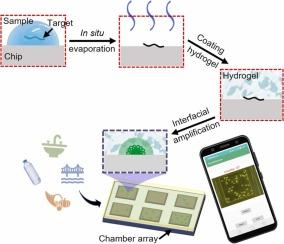Sensitivity-Enhanced Hydrogel Digital RT-LAMP with In Situ Enrichment and Interfacial Reaction for Norovirus Quantification in Food and Water
IF 12.2
1区 环境科学与生态学
Q1 ENGINEERING, ENVIRONMENTAL
引用次数: 0
Abstract
Low levels of human norovirus (HuNoV) in food and environment present challenges for nucleic acid detection. This study reported an evaporation-enhanced hydrogel digital reverse transcription loop-mediated isothermal amplification (HD RT-LAMP) with interfacial enzymatic reaction for sensitive HuNoV quantification in food and water. By drying samples on a chamber array chip, HuNoV particles were enriched in situ. The interfacial amplification of nucleic acid at the hydrogel-chip interface was triggered after coating HD RT-LAMP system. Nanoconfined spaces in hydrogels provided a simple and rapid “digital format” to quantify single virus within 15 min. Through in situ evaporation for enrichment, the sensitivity level was increased by 20 times. The universality of the sensitivity-enhanced assay was also verified using other bacteria and virus. Furthermore, a deep learning model and smartphone app were developed for automatic amplicon analysis. Multiple actual samples, including 3 lake waters, strawberry, tap water and drinking water, were in situ enriched and detected for norovirus quantification using the chamber arrays. Therefore, the sensitivity-enhanced HD RT-LAMP is an efficient assay for testing biological hazards in food safety monitoring and environmental surveillance.

具有原位富集和界面反应的灵敏度增强水凝胶数字RT-LAMP用于食物和水中诺如病毒的定量分析
人类诺如病毒在食品和环境中的低水平对核酸检测提出了挑战。本研究报道了一种蒸发增强水凝胶数字逆转录环介导等温扩增(HD RT-LAMP)与界面酶反应,用于食品和水中的HuNoV的敏感定量。通过在腔室阵列芯片上干燥样品,HuNoV颗粒在原位富集。涂覆HD RT-LAMP系统后,触发水凝胶-芯片界面处核酸的界面扩增。水凝胶中的纳米密闭空间提供了一种简单快速的“数字格式”,可在15分钟内定量单个病毒。通过原位蒸发富集,灵敏度水平提高了20倍。用其他细菌和病毒验证了敏感性增强试验的普遍性。此外,还开发了用于自动扩增子分析的深度学习模型和智能手机应用程序。对3种湖水、草莓、自来水和饮用水等多种实际样品进行原位富集,并利用室阵列进行诺如病毒定量检测。因此,灵敏度增强的HD RT-LAMP是食品安全监测和环境监测中检测生物危害的有效方法。
本文章由计算机程序翻译,如有差异,请以英文原文为准。
求助全文
约1分钟内获得全文
求助全文
来源期刊

Journal of Hazardous Materials
工程技术-工程:环境
CiteScore
25.40
自引率
5.90%
发文量
3059
审稿时长
58 days
期刊介绍:
The Journal of Hazardous Materials serves as a global platform for promoting cutting-edge research in the field of Environmental Science and Engineering. Our publication features a wide range of articles, including full-length research papers, review articles, and perspectives, with the aim of enhancing our understanding of the dangers and risks associated with various materials concerning public health and the environment. It is important to note that the term "environmental contaminants" refers specifically to substances that pose hazardous effects through contamination, while excluding those that do not have such impacts on the environment or human health. Moreover, we emphasize the distinction between wastes and hazardous materials in order to provide further clarity on the scope of the journal. We have a keen interest in exploring specific compounds and microbial agents that have adverse effects on the environment.
 求助内容:
求助内容: 应助结果提醒方式:
应助结果提醒方式:


